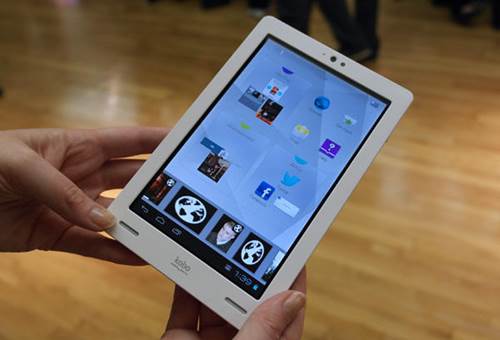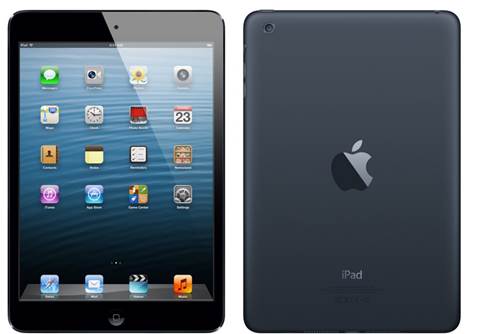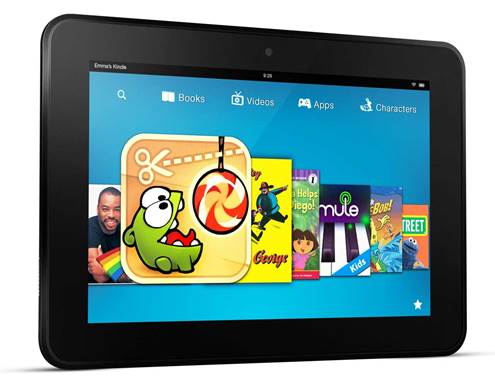Software swings and roundabouts
As you can imagine though, by now tablets
have become commoditized. Just about any company with enough budgets can knock
one together in China and get it on store shelves somewhere. More than ever,
it’s the software that really counts, and the Arc’s is both its best feature
and its worst.
The Arc runs Android 4.0 with a custom home
screen launcher that puts recommendations and available downloads from the Kobo
eBook store front and center, so you can get stuck in and start reading right
away. It’s a tad confusing (you can create folders as you typically can on
Android, but they act as new home screens instead of popping up on the one
you’re on) but the basics of Android remain the same: you can multi-task
between apps using the on-screen button, notifications come trickling into the
pop up tray, quietly and as unobtrusively as you’d prefer, and the Google
Chrome browser is simply the best tablet web experience on the planet right
now.

The
Arc runs Android 4.0 with a custom home screen launcher that puts
recommendations and available downloads from the Kobo eBook store front and
center
There’s only so many ways you can make an
e-reader store and service meanwhile, and Kobo’s service is more than adequate
for bookworms. We Wi-Fi say that Amazon’s store is better stocked, while Barnes
& Noble provides the best comic reading experience with its frame by frame
zooming. Kobo meanwhile lacks its own video service in the UK, but it’s not
really a problem, since you can rent and buy movies and TV shows from the
Google Play store.
But the whole point is almost moot, because
you can use ail three services, and any others, if you so choose. It’s the
openness of being able to use Google’s services and app-packed store (which
include Kindle and Nook apps - check the sidebar for more info) and even
install apps from anywhere else on the web that makes the Kobo Arc such a
breath of fresh air.
“The Nexus 7 still offers the same
e-reader apps, and much faster software...”
Sadly, what doesn’t is the older version of
Android. Version 4.0, codenamed ‘Ice Cream Sandwich’, is more than a year old
at this point. Though visually little has changed in that time, and it remains
attractive and easy to use, Google has released two more major updates (4.1 and
4.2 “Jelly Bean”) since, with extra features (such as multiple account support
on tablets, smarter voice recognition and more), and crucially, many under the
bonnet improvements that make Jelly Bean night and day faster to use.

The
thing that makes the Arc different from other bookseller offerings is that it’s
a Google-certified device, so you’ll have access to all of the core apps like
Gmail, YouTube, Google Maps, and so on, plus anything in the Google Play
Store.
Kobo says that an update to 4.1 will
arrive, but doesn’t yet have a date penciled in the diary: meanwhile, Asus has
already pushed out blazing fast Android 4.2 to the Google Nexus 7. Ultimately,
for all Kobo’s good intentions, it’s this clockwork release schedule, made
possible by close cooperation with Google that makes the Arc or any other seven
inch tablet under $300 - a hard sell. Why go with it when the Nexus 7 still
offers the same e-reader apps, and much faster software? No company, big or
small, has managed a convincing answer for that yet.
The Kobo’s seven inch rivals
iPad Mini

iPad
Mini
From $403.5,
the iPad Mini is the most controversial and successful of all the 7-inch
tablets. It is little more than a shrunk down, obsolete, iPad 2. Yes you get a
relatively nice hardware design, and access to Apple’s industry leading App
store. Whether that’s worth the extortionate pricing is up to the buyer - Apple
certainly hasn’t had any problems shifting millions of them. What Mobile
recommends spending a tad more on a 10-inch iPad, which is vastly superior.
Google Nexus 7

Google
Nexus 7
From $238.5,
the Google Nexus 7 remains the elite option in the 7-inch tablet market. It has
a powerful quad-core 1.2GHz Cortex A-9 processor which means it runs any Apps
easily. It’s 800x1280 pixel screen makes for clear reading. It really is dirt
cheap for what you get, and open access to the Google Play store means all the
magazines, apps, games and movies your heart desires - and it comes free of the
intrusive bloatware other devices get stuck with.
Kindle Fire HD

Kindle
Fire HD
From $238.5, the Kindle Fire really started off the 7-inch tablet craze, but
remains the weakest on offer. Firstly, the $238.5version is filled with
intrusive ads. The processor is a dual core A9 - weaker than the Nexus 7, and
the screen is average. The interface is cluttered and shudders in general use.
The biggest tailing is that you are locked into Amazon’s limited App Store - no
access to Google’s. For the same price, why not buy the Nexus 7?
Barnes & Noble Nook HD

Barnes
& Noble Nook HD
From $298.5, while the Nook RD has a stunning 1440x900 screen (better than all
the others) it suffers from the same mistakes as Amazon’s - namely B&N have
locked users into its own App Store. Users will not be able to use any of the
Google Play store’s apps, movies, games and music, and will be stuck using a US
book company’s limited offerings. It also chugs along due to its average 1.3GHz
dual core processor. Disappointing.